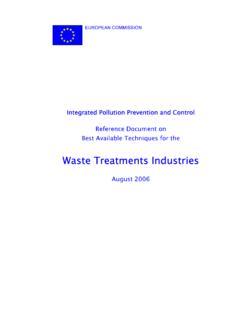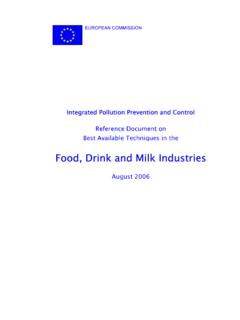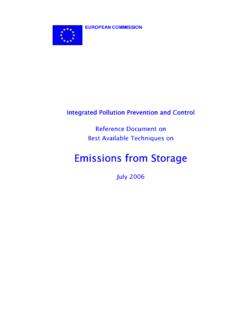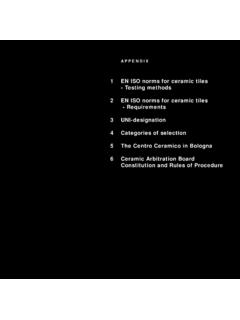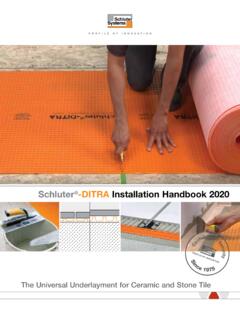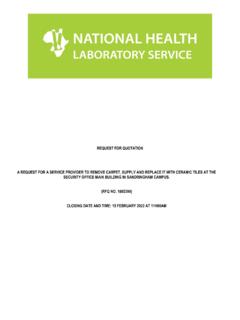Transcription of Ceramic Manufacturing Industry - Europa
1 EUROPEAN COMMISSION Reference Document on Best Available Techniques in the Ceramic Manufacturing Industry August 2007 This document is one of a series of foreseen documents as below (at the time of writing, not all documents have been finalised): Reference Document on Best Available Techniques .. Code Large Combustion Plants LCP Mineral Oil and Gas Refineries REF Production of Iron and Steel I&S Ferrous Metals Processing Industry FMP Non Ferrous Metals Industries NFM Smitheries and Foundries Industry SF Surface Treatment of Metals and Plastics STM Cement and Lime Manufacturing Industries CL Glass Manufacturing Industry GLS Ceramic Manufacturing Industry CER Large Volume Organic Chemical Industry LVOC Manufacture of Organic Fine Chemicals OFC Production of Polymers POL Chlor Alkali Manufacturing Industry CAK Large Volume Inorganic Chemicals - Ammonia.
2 Acids and Fertilisers Industries LVIC-AAF Large Volume Inorganic Chemicals - Solid and Others Industry LVIC-S Production of Speciality Inorganic Chemicals SIC Common Waste Water and Waste Gas Treatment/Management Systems in the Chemical Sector CWW Waste Treatments Industries WT Waste Incineration WI Management of Tailings and Waste-Rock in Mining Activities MTWR Pulp and Paper Industry PP Textiles Industry TXT Tanning of Hides and Skins TAN Slaughterhouses and Animals By-products Industries SA Food, Drink and Milk Industries FDM Intensive Rearing of Poultry and Pigs ILF Surface Treatment Using Organic Solvents STS Industrial Cooling Systems CV Emissions from Storage ESB Reference Document .. General Principles of Monitoring MON Economics and Cross-Media Effects ECM Energy Efficiency Techniques ENE Electronic versions of draft and finalised documents are publically available and can be downloaded from Summary Ceramic Manufacturing Industry i EXECUTIVE SUMMARY The BAT (Best Available Techniques) Reference Document (BREF) entitled Ceramic Manufacturing (CER) reflects an information exchange carried out under Article 16(2) of Council Directive 96/61/EC (IPPC Directive).
3 This executive summary describes the main findings, a summary of the principal BAT conclusions and the associated consumption and emission levels. It should be read in conjunction with the preface, which explains this document s objectives; how it is intended to be used and legal terms. It can be read and understood as a standalone document but, as a summary, it does not present all the complexities of this full document. It is therefore not intended as a substitute for this full document as a tool in BAT decision making and it has to be stressed again that this summary cannot correctly be interpreted unless it is read in conjunction with Chapters 4 and 5.
4 SCOPE OF THIS DOCUMENT This document addresses the industrial activities specified in Section of Annex I to Directive 96/61/EC, namely: Installations for the manufacture of Ceramic products by firing, in particular roofing tiles, bricks, refractory bricks, tiles, stoneware or porcelain, with a production capacity exceeding 75 tonnes per day, and/or with a kiln capacity exceeding 4 m and with a setting density per kiln exceeding 300 kg/m . For the purposes of this document the industrial activities falling within this description will be referred to as the Ceramic Industry . The major sectors which are based on the Ceramic products (ceramics) manufactured are as follows: wall and floor tiles bricks and roof tiles table- and ornamentalware (household ceramics) refractory products sanitaryware technical ceramics vitrified clay pipes expanded clay aggregates inorganic bonded abrasives.
5 In addition to the basic Manufacturing activities, this document covers the directly associated activities which could have an effect on emissions or pollution. Thus, this document includes activities from the preparation of raw materials to the dispatch of finished products. Certain activities, such as the quarrying of raw materials, are not covered because they are not considered to be directly associated with the primary activity. THE Ceramic Industry Generally the term ceramics ( Ceramic products) is used for inorganic materials (with possibly some organic content), made up of non-metallic compounds and made permanent by a firing process. In addition to clay based materials, today ceramics include a multitude of products with a small fraction of clay or none at all.
6 Ceramics can be glazed or unglazed, porous or vitrified. Firing of Ceramic bodies induces time-temperature transformation of the constituent minerals, usually into a mixture of new minerals and glassy phases. Characteristic properties of Ceramic products include high strength, wear resistance, long service life, chemical inertness and non-toxicity, resistance to heat and fire, (usually) electrical resistance and sometimes also a specific porosity. Executive Summary ii Ceramic Manufacturing Industry Clay raw materials are widely distributed throughout Europe, so Ceramic products like bricks which are relatively inexpensive (but which incur high transport costs due to their weight) are manufactured in virtually all Member States.
7 Building traditions and heritage considerations result in different unit sizes from country to country. More specialised products which command higher prices tend to be mainly produced in a few countries, which have the necessary special raw materials and equally important traditions of skill and expertise. KEY ENVIRONMENTAL ISSUES Depending on the specific production processes, plants Manufacturing Ceramic products cause emissions to be released into air, water and land (waste). Additionally, the environment can be affected by noise and unpleasant smells. The type and quantity of air pollution, wastes and waste water depend on different parameters. These parameters are, the raw materials used, the auxiliary agents employed, the fuels used and the production methods: emissions to air: particulate matter/dust, soot, gaseous emissions (carbon oxides, nitrogen oxides, sulphur oxides, inorganic fluorine and chlorine compounds, organic compounds and heavy metals) can arise from the manufacture of Ceramic products emissions to water: process waste water mainly contains mineral components (insoluble particulate matter) and also further inorganic materials, small quantities of numerous organic materials as well as some heavy metals process losses/waste.
8 Process losses originating from the manufacture of Ceramic products, mainly consist of different kinds of sludge, broken ware, used plaster moulds, used sorption agents, solid residues (dust, ashes) and packaging waste energy consumption/CO2emissions: all sectors of the Ceramic Industry are energy intensive, as a key part of the process involves drying followed by firing to temperatures of between 800 and 2000 C. Today natural gas, liquefied petroleum gas (propane and butane) and fuel oil EL are mainly used for firing, while heavy fuel oil, liquefied natural gas (LNG), biogas/biomass, electricity and solid fuels ( coal, petroleum coke) can also play a role as energy sources for burners.
9 APPLIED PROCESSES AND TECHNIQUES The manufacture of Ceramic products takes place in different types of kilns, with a wide range of raw materials and in numerous shapes, sizes and colours. The general process of Manufacturing Ceramic products, however, is rather uniform, besides the fact that for the manufacture of wall and floor tiles, household ceramics, sanitaryware and technical ceramics often a multiple stage firing process is used. In general, raw materials are mixed and cast, pressed or extruded into shape. Water is regularly used for a thorough mixing and shaping. This water is evaporated in dryers and the products are either placed by hand in the kiln especially in the case of periodically operated shuttle kilns or placed onto carriages that are transferred through continuously operated tunnel or roller hearth kilns.
10 For the manufacture of expanded clay aggregates, rotary kilns are used. During firing a very accurate temperature gradient is necessary to ensure that the products obtain the right treatment. Afterwards controlled cooling is necessary, so that the products release their heat gradually and preserve their Ceramic structure. Then the products are packaged and stored for delivery. Executive Summary Ceramic Manufacturing Industry iii EMISSIONS AND CONSUMPTIONS Emissions The processing of clays and other Ceramic raw materials inevitably leads to dust formation especially in the case of dry materials. Drying, (including spray drying), comminution (grinding, milling), screening, mixing and conveying can all result in a release of fine dust.




